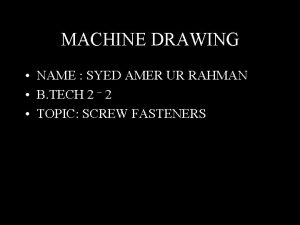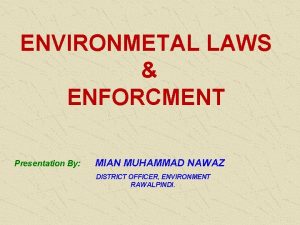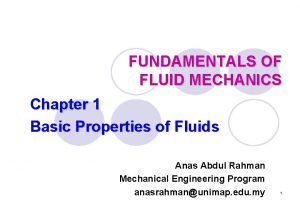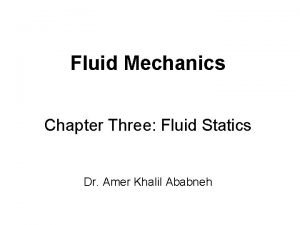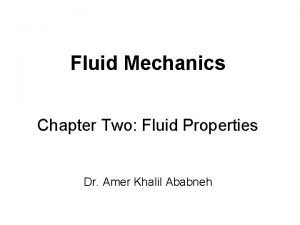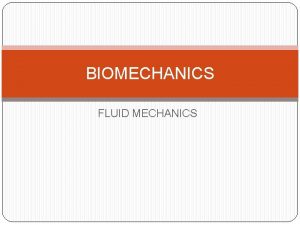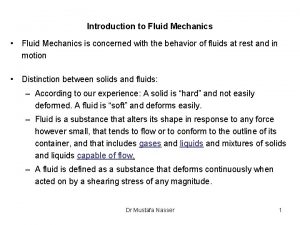Fluid Mechanics Chapter One Introduction Dr Amer Khalil












- Slides: 12

Fluid Mechanics Chapter One: Introduction Dr. Amer Khalil Ababneh

Fluid Mechanics is the field of science focused on the motion of material bodies. Mechanics involves force, energy, motion, deformation, and material properties. When mechanics applies to material bodies in the solid phase, the discipline is called solid mechanics. When the material body is in the gas or liquid phase, the discipline is called fluid mechanics

More about Definition of Fluids Unlike solid, a fluid is a substance whose molecules move freely past each other. More specifically, a fluid is a substance that will continuously deform—that is, flow under the action of a shear stress. Alternatively, a solid will deform under the action of a shear stress but will not flow like a fluid. Both liquids and gases are classified as fluid

1. 1 Liquids and Gases The difference between Liquids and gases is because of forces between the molecules. liquid will take the shape of a container whereas a gas will expand to fill a closed container. The behavior of the liquid is produced by strong attractive force between the molecules. This strong attractive force also explains why the density of a liquid is much higher than the density of gas. A gas is a phase of material in which molecules are widely spaced, molecules move about freely, and forces between molecules are minuscule, except during collisions. Alternatively, a liquid is a phase of material in which molecules are closely spaced, molecules move about freely, and there are strong attractive forces between molecules. See Table 1. 1.

1. 2 The Continuum Assumption While a body of fluid is comprised of molecules, most characteristics of fluids are due to average molecular behavior. That is, a fluid often behaves as if it were comprised of continuous matter that is infinitely divisible into smaller and smaller parts. This idea is called the continuum assumption. When the continuum assumption is valid, engineers can apply limit concepts from differential calculus. Recall that a limit concept, for example, involves letting a length, an area, or a volume approach zero. Because of the continuum assumption, fluid parameters such as density and velocity can be considered continuous functions of position with a value at each point in space.

More on Continuum Assumption To gain insight into the validity of the continuum assumption, consider a hypothetical experiment to find density. Fig. 1. 1 a shows a container of gas in which a volume has been identified. The idea is to find the mass of the molecules DM inside the volume and then to calculate density by The calculated density is plotted in Fig. 1. 1 b. When the measuring volume is very small (approaching zero), the number of molecules in the volume will vary with time because of the random nature of molecular motion. Thus, the density will vary as shown. As volume increases, the variations in calculated density will decrease until the calculated density is independent of the measuring volume. This condition corresponds to the vertical line at. If the volume is too large, as shown by , then the value of density may change due to spatial variations.

Continuum Assumption Figure 1. 1

Continuum Assumption In most engineering applications, continuum assumption is valid. To demonstrate this, compute the volume required to have 106 molecules. Using Avogadro number (~6 x 1023 molecules/mole), the limiting volume for water is 10 -13 mm 3 (or <10 -4 mm cube). For ideal gas at standard conditions, the limiting volume is 10 -10 mm 3 (or <10 -3 mm cube).

1. 3 Dimensions and Units A dimension is a category that represents a physical quantity such as mass, length, time, momentum, force, acceleration, and energy. To simplify matters, engineers express dimensions using a limited set that are called primary dimensions. Table 1. 2 lists one common set of primary dimensions. Table 1. 2 PRIMARY DIMENSIONS Dimension Symbol Unit (SI) Length L meter (m) Mass M kilogram (kg) Time T second (s) Temperature θ kelvin (K) Electric current i ampere (A) Amount of light C candela (cd) Amount of matter mole (mol)

Secondary dimensions such as momentum and energy can be related to primary dimensions by using equations. For example, the secondary dimension “force” is expressed in primary dimensions by using Newton's second law of motion, F = ma. The primary dimensions of acceleration are L/T 2, so

Units While a dimension expresses a specific type of physical quantity, a unit assigns a number so that the dimension can be measured. For example, measurement of volume (a dimension) can be expressed using units of liters. Similarly, measurement of energy (a dimension) can be expressed using units of joules. Most dimensions have multiple units that are used for measurement. For example, the dimension of “force” can be expressed using units of newtons, pounds-force, or dynes.

Suggested Problems 1. 1 For each variable below, list three common units. a. Volume flow rate (Q), mass flow rate (m), and pressure (p). b. Force, energy, power. c. Viscosity. 1. 5 Find the primary dimensions of each of the following terms. a. (ρV 2)/2 (kinetic pressure), where ρ is fluid density and V is velocity. b. T (torque). c. P (power). d. (ρV 2 L)/δ (Weber number), where ρ is fluid density, V is velocity, L is length, and σ is surface tension.

